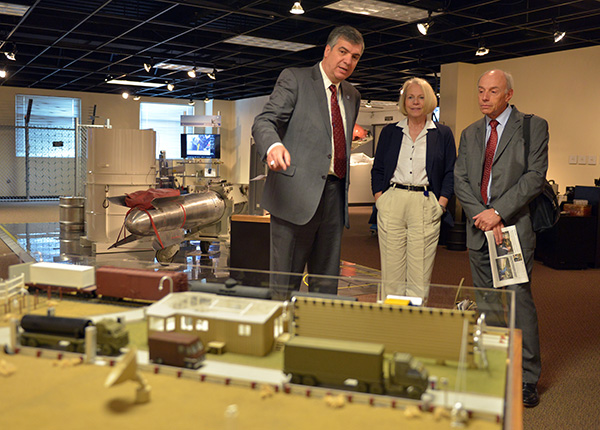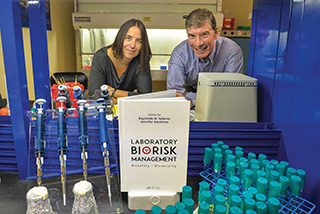Protecting nuclear materials and facilities

Pablo Garcia (left) discusses Sandia’s work in nuclear safety with Anne Harrington of the NNSA and Denis Flory of the IAEA. Harrington and Flory toured Sandia’s facilities during the 25th International Training Course.
From April 20-May 8, 2015, Sandia hosted 43 nuclear security students from 36 nations for the 25th International Training Course (ITC) on the Physical Protection of Nuclear Material and Nuclear Facilities. Top officials from Sandia, NNSA, and the International Atomic Energy Agency welcomed the students. Every 18 months for the past 37 years, Sandia has hosted the ITC, thus far training more than 800 people from 73 countries. The two-week course provides technical experience and helps build connections among members. (6800) IHNS, GNAS
During 2015 Sandia hosted two visits by delegations of international nonproliferation and disarmament officials. They came to learn about the Labs’ work related to the Treaty on the Non-Proliferation of Nuclear Weapons (NPT). The delegates represented 19 non-weapons states, the UN Office of Disarmament Affairs, and NATO. Both delegations were given tours of Sandia technical facilities where important NPT work is conducted. The goal of these transparency visits was to introduce the officials to Sandia’s workforce and to demonstrate our technologies that support nonproliferation, arms control, and US implementation of the NPT. (6800) IHNS, GNA
The Starlite – Synthetic Aperture Radar (SAR) – Coherent Change Detection (CCD) development, funded by the US Army, was conducted by Neall Doren (5962). It resulted in the delivery of CCD software and documentation. The objective was a CCD software package that will allow CCD imagery for improvised explosive device detection. The intent of the work is to provide the Grey Eagle UAV/Starlite SAR System the capability of both the Copperhead radar/UAV and Desert Owl radar system to detect IEDs on the battlefield. (5900) DSA, SDP
The Daily Watch Program developed by Neall Doren is a new analysis tool for the US government. This technology has seen a steady increase in user requests from 100 requests a month three years ago to more than 1,000 per month. The FY15 software, delivered and assimilated by the government, is based on a joint effort between organizations 5448 and 5962 and takes advantage of organization 5448’s Automatic Target Recognition research and development technology. (5400, 5900) DSA, GNAS
Biorisk management

In May 2015, CRC Press published a book edited by Jen Gaudioso (6820) and former Sandian Ren Salerno, Laboratory Biorisk Management: Biosafety and Biosecurity. This book introduces a substantively new approach for managing the risks of working with biological agents in laboratories. The basis for this new biorisk management paradigm is a three-pronged multidisciplinary model of assessment, mitigation, and performance (the AMP model). The application of the methodologies, criteria, and guidance outlined in the book helps reduce the risk of laboratories becoming the source of infectious disease outbreaks. (8600, 6800) IHNS, RGCBD